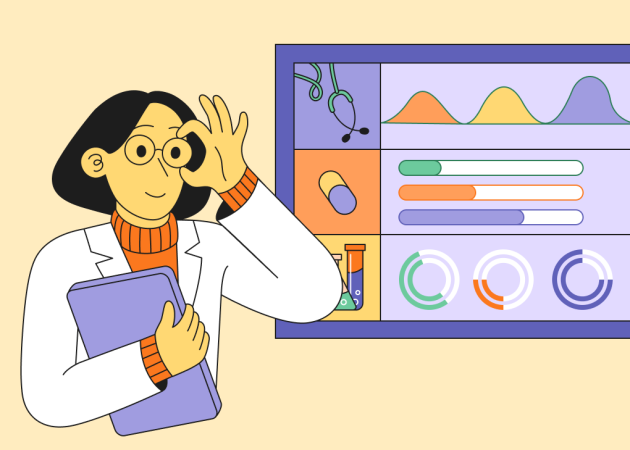
Technology Trends in Healthcare: 10 Key Shifts Shaping 2025
Contents
Contents
From telehealth platforms and AI-driven diagnostics to connected care tools, healthtech companies are entering a phase where thoughtful execution matters just as much as speed. Innovation is shifting from short-term pilots to long-term impact, with a growing emphasis on building solutions that are secure, interoperable, and intuitive to use.
The global digital health market is projected to grow from $427.24 billion in 2025 to over $1.5 trillion by 2032. As demand continues to rise, so does the pressure to build solutions that are not only functional, but scalable, compliant, and deeply aligned with user needs.
In this article, we take a closer look at the tech trends in healthcare — based on what we’re seeing in the field, supported by industry research, and shaped by real-world collaboration with healthcare teams. Whether you’re planning your product roadmap, scaling your team, or rethinking your architecture, these insights are here to support your next strategic move.
Generative AI for Clinical and Operational Use
Generative AI has started to shape how clinical and operational teams handle routine tasks. According to a McKinsey report, 65 % of healthcare leaders stated that generative AI is part of regular workflows. These tasks range from drafting medical notes and summarizing patient histories to automating prior authorization forms and generating patient-facing communication. The focus remains on saving time without adding complexity to existing workflows.
AI in clinical notes is rising among healthcare tech trends
One area where gen AI is starting to show real impact is clinical documentation. New tools are helping clinicians spend less time on note-taking and more time with patients. On the operational side, AI is being tested to streamline intake processes, assist call center staff, and make internal reporting more manageable. But to make any of this work in practice, these tools need to connect smoothly with existing systems like EHRs. That means thinking carefully about infrastructure, APIs, and how sensitive data is handled from the start.
AI technology trends in healthcare go beyond the algorithm
As AI becomes more embedded in workflows, organizations face new questions about reliability, transparency, and how to keep human oversight in the loop. There’s growing awareness that success doesn’t hinge only on the model, but on the way it’s implemented, from user experience to governance.
Building effective generative AI solutions in healthcare means thinking beyond the algorithm. You need the right mix of engineering expertise, healthcare understanding, and change management. It also means upskilling internal teams to work effectively with AI, not just technically, but also in terms of decision-making and ethical awareness.
At this stage, digital health companies are looking for partners who can help them move from experimentation to sustainable adoption, making sure generative AI fits into their long-term technology roadmap without introducing unnecessary risk.

Cybersecurity in Healthcare as a Strategic Priority
As healthcare organizations increase their reliance on digital systems, cybersecurity is becoming a board-level concern in the future of health care technology. The risks are no longer hypothetical as ransomware attacks, data breaches, and third-party vulnerabilities continue to disrupt care delivery and erode patient trust.
What’s shifting in 2025 is the strategic framing of cybersecurity. It’s no longer enough for your team to rely on reactive defenses or periodic audits. Instead, you need to incorporate security considerations into every stage of software planning and delivery.
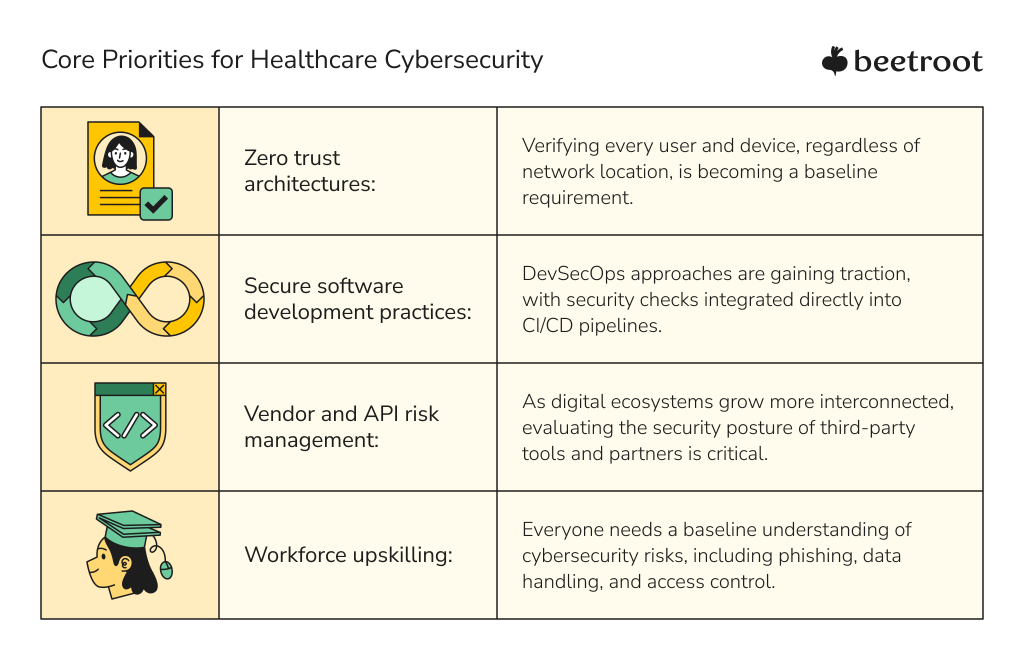
With more sensitive data flowing through patient portals, remote monitoring devices, and AI-driven clinical systems, your software teams must build systems that can scale securely under regulatory and operational pressure. This includes designing privacy-by-default architectures and building in breach resilience, not just breach response.
The question is no longer if cybersecurity will impact development priorities, but how prepared your team is to manage that impact from day one.
Digital Therapeutics (DTx) and Remote Monitoring Tools
As healthcare shifts toward continuous, personalized care, digital therapeutics (DTx) and remote monitoring tools are becoming essential components of treatment plans, especially for chronic and behavioral conditions. The global digital therapeutics market was estimated at $7.67 billion in 2024, with projections reaching $32.5 billion by 2030 — a sign of sustained momentum and investor interest in this space.
Moving Beyond One-Time Interventions
Unlike traditional health apps, DTx solutions are evidence-based interventions designed to treat or manage diseases through software alone or alongside other therapies. They’re often prescribed like medications, with clinical protocols, dosage schedules, and real-time data collection. Remote patient monitoring, meanwhile, uses connected devices, from smart inhalers to glucose monitors to track patient health between visits and enable timely interventions.
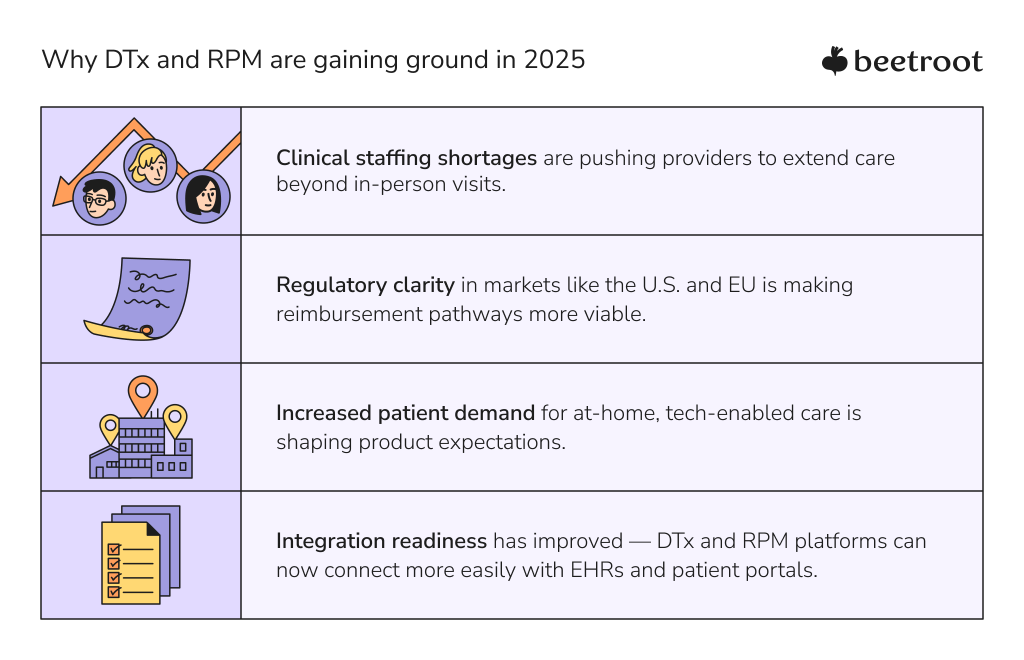
Development Considerations
For digital health companies, the challenge isn’t just building apps, it’s about building safe, compliant, and scalable care systems. This includes ensuring accurate data collection, managing asynchronous clinician workflows, and navigating complex approval processes. Product teams must also design with accessibility and adherence in mind, knowing that long-term outcomes depend not just on emerging healthcare technologies, but on sustained patient engagement.
Platformization and Interoperability-First Development
As healthcare organizations grow their digital ecosystems, interoperability is no longer just a box to check — it’s becoming a core part of product strategy. Rather than building standalone tools, more teams are now focused on creating platforms that work effortlessly with EHRs, third-party APIs, and the tools patients already use.
This shift supports faster scaling, easier data exchange, and a more cohesive user experience across the care journey. But it also requires a technical mindset change, from application silos to systems thinking.
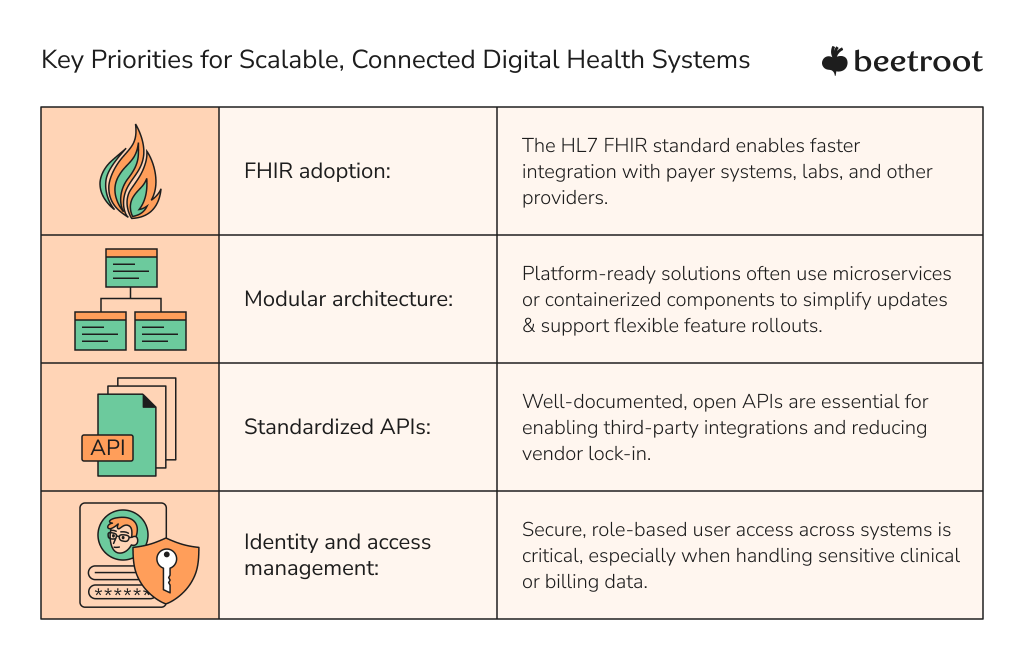
This platformization approach is especially relevant if you are looking to serve large providers, payers, or cross-border care networks. One example is the development of telenursing apps that connect medical staff, patients, and family caregivers in real time. These platforms often need to integrate with hospital systems, wearables, and remote monitoring tools, requiring strong interoperability foundations from day one.
Our work on the Eshmun Telenursing App followed this approach. The solution was designed with modular architecture and a focus on connecting diverse user types, clinicians, patients, and caregivers through a secure, scalable telehealth platform.
Interoperability-first development not only improves clinical workflows but also supports regulatory compliance and future-proofing, which helps teams adapt as standards and data requirements evolve.

AI-Augmented Decision Support for Clinicians
AI is increasingly becoming a supportive layer in clinical decision-making, helping care teams process large volumes of data, surface critical insights, and prioritize what matters most. Rather than replacing clinical expertise, AI tools are being designed to complement it, giving you and your team more time to focus on patients.
If you’re exploring how to bring AI into clinical workflows, the biggest challenge isn’t just about choosing the right model, it’s about building trust, usability, and relevance into the final product. A well-built tool should feel like a natural extension of the clinician’s thought process, not an extra step to manage.
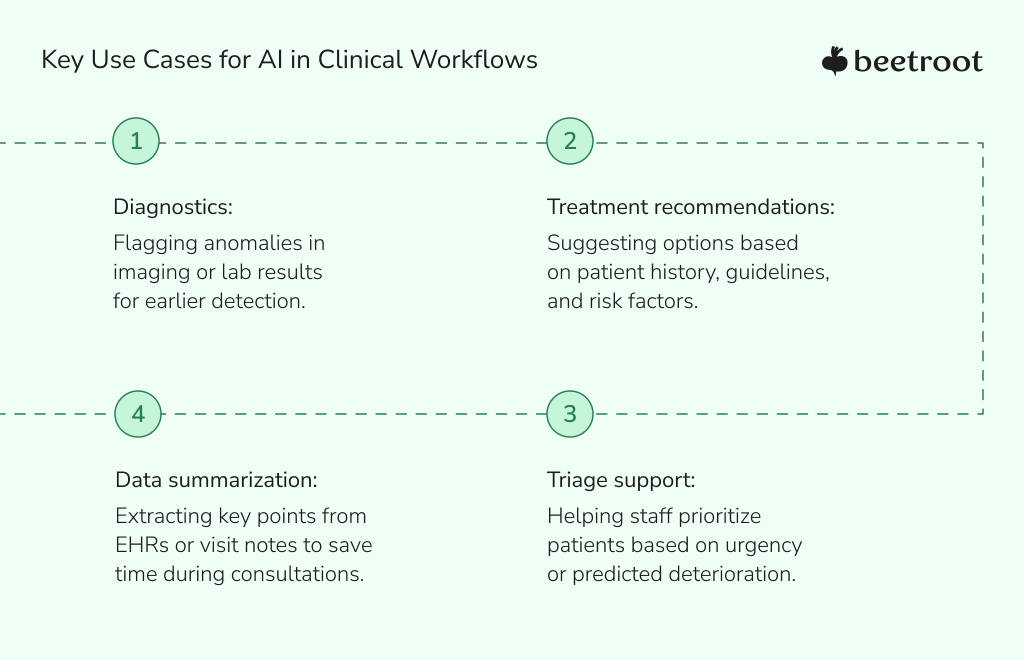
But even the most advanced model won’t drive impact if it disrupts clinical flow or overwhelms staff. Alert fatigue, opaque decision logic, and lack of context are common barriers to adoption. That’s why implementation needs to be as thoughtful as the technology itself.
To make these tools truly effective, design decisions must center on clarity, control, and integration. AI can be a powerful clinical partner, but only when your team feels confident in how it works and when to trust it.
Value-Based and Outcome-Driven Tech Investments
As healthcare systems move away from fee-for-service models, value-based care is reshaping how digital products are evaluated and funded. It’s no longer enough for your solution to “work”, it also needs to demonstrate real-world impact on patient outcomes, care coordination, and cost efficiency.
This shift is influencing both what gets built and how success is measured. Instead of focusing solely on technical delivery, digital health teams are increasingly expected to align their products with measurable clinical or operational goals.
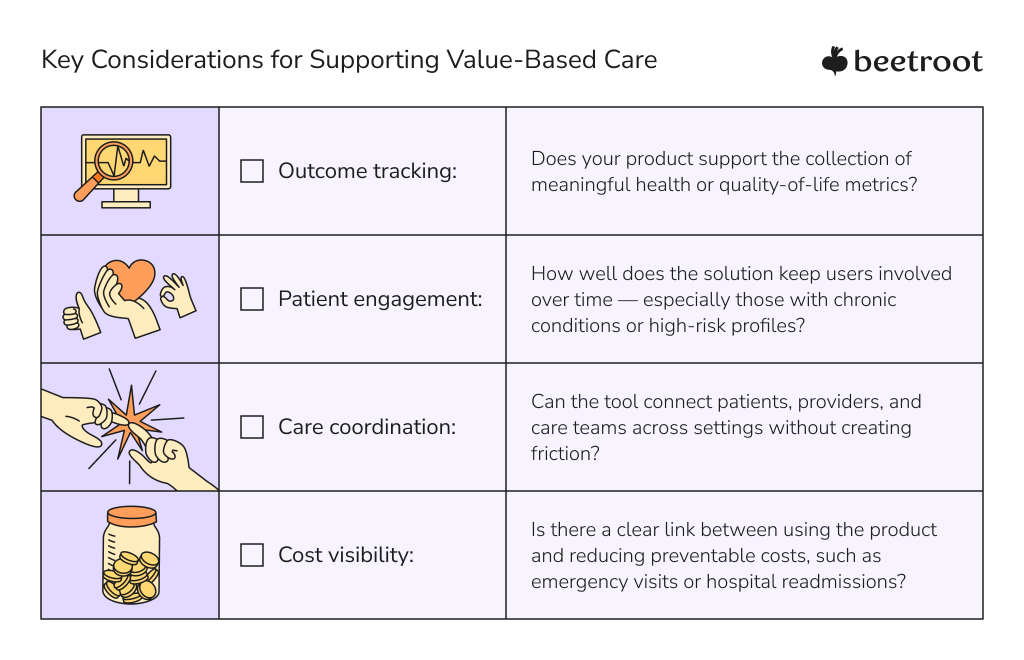
Healthtech products that contribute to better outcomes are more likely to attract partnerships, payer support, and long-term adoption. But achieving that means more than adding reporting features, it requires building for interoperability, behavior change, and long-term retention.
If your team is working on a product in this space, now’s the time to think about value not just as a business case, but as something your users, partners, and patients can see and feel.
Digital Front Doors and Consumerized Patient Experiences
Patients today expect the same level of digital convenience from healthcare that they experience in other parts of life, whether it’s booking a flight, managing finances, or shopping online. This rising expectation is prompting healthcare organizations to rethink their entry points. The “front door” is no longer just the reception desk, it’s your website, your mobile app, your automated messages, and how easily patients can access care on their terms.
For your team, the challenge is creating a consistent and accessible experience across all channels, not just building another app, but developing a patient journey that feels seamless from first contact to follow-up care.
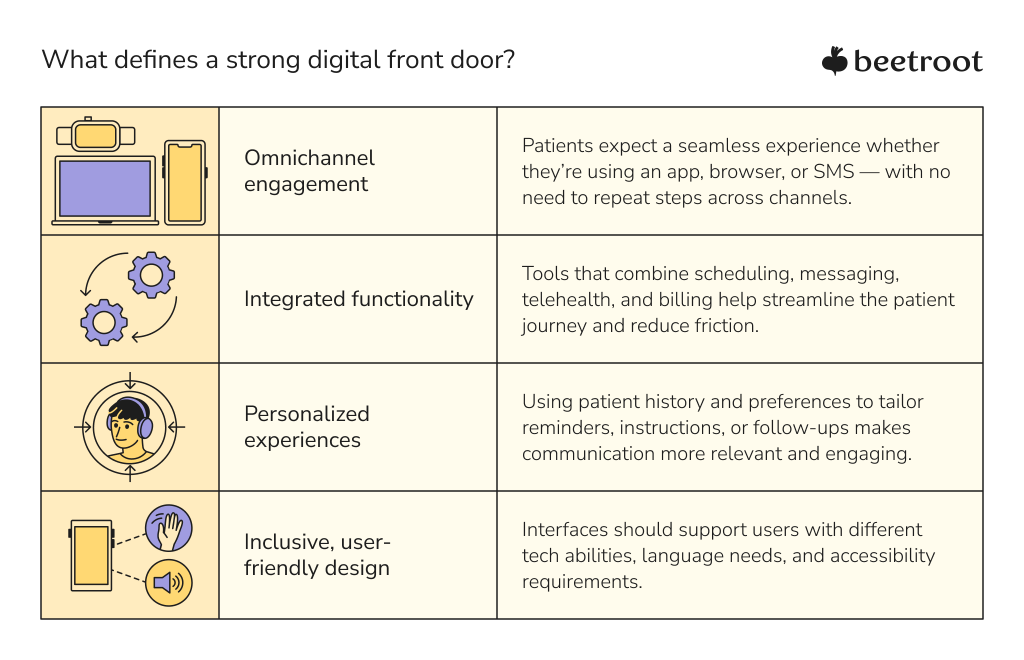
As more touchpoints shift online, your digital presence becomes a key competitive differentiator. What used to be “nice to have” is quickly becoming the baseline.
The Internet of Things (IoT) in Healthcare
Connected medical devices are becoming a foundational part of how care is delivered, monitored, and adjusted in real time. From wearables and at-home sensors to hospital equipment and implantables, the healthcare Internet of Things (IoT) continues to expand, creating new opportunities for both patient care and operational efficiency.
If you’re building or integrating digital health solutions, you’ve likely seen the shift: care is moving beyond the clinic, and data is flowing in from all directions. The challenge now is turning that stream into something usable, actionable, and secure.
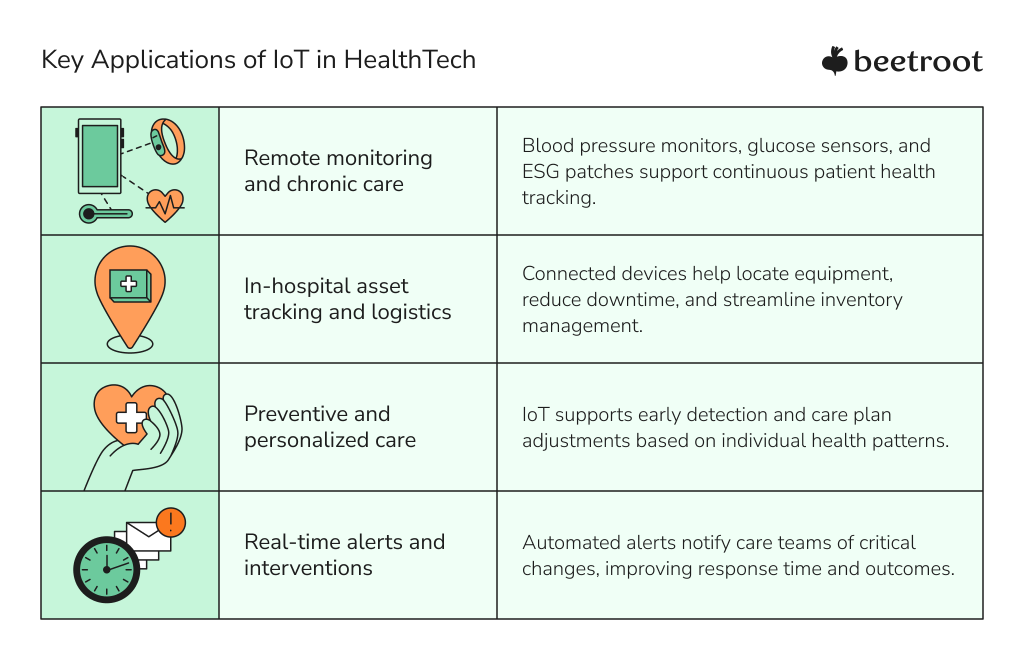
As adoption grows, the key questions shift from what can we connect to how can we connect it responsibly and meaningfully? That’s where thoughtful design, integration strategy, and data governance all come into play.
Clinical Workflow Integration as a Competitive Advantage
In the race to deliver digital health innovation, seamless clinical workflow integration is becoming a key success factor. No matter how advanced or well-funded your product is, if it doesn’t align with how care teams actually work, adoption stalls or fails altogether.
Solving for integration isn’t just about technical compatibility. It’s about designing tools that respect the time, habits, and decision-making processes of clinicians. For your team, that means shifting the focus from building features to removing friction.
Here are a few signals that your product is truly integrated into clinical workflows:
- Minimal context switching. Clinicians can access and use the tool without leaving their primary system, often directly within the EHR or patient chart view.
- No redundant data entry. Information flows automatically between systems, reducing the risk of errors and saving time across the care team.
- Embedded triggers and nudges. AI suggestions, alerts, or documentation support appear at the right moment in the workflow, not before or after.
-
Co-created processes. The tool reflects actual practice patterns because frontline users were involved early in design and testing.
As providers become more selective about the tools they bring into clinical environments, integration is no longer optional. Treating workflow alignment as a product feature, not a technical afterthought can make the difference between meaningful adoption and shelfware.
Regulatory Pressure and Evolving Standards
As healthtech innovation picks up speed, regulatory frameworks are moving quickly to keep pace, and that shift is influencing how digital products are being built. For development teams, compliance is no longer a final checklist item. It’s something that needs to be considered from the first wireframe to post-launch monitoring.
In 2025, much of the focus falls on how new technologies in healthcare industry, particularly AI are governed. With frameworks like the EU AI Act gaining traction and new guidance emerging from agencies like the FDA, there’s growing pressure to demonstrate transparency, safety, and oversight in how algorithms are designed and deployed. At the same time, regulations around data privacy and cross-border processing continue to tighten, requiring more robust infrastructure and clearer documentation around how patient information is collected, stored, and shared.
Interoperability mandates are also becoming more specific, pushing healthtech products to integrate with existing systems in consistent, standards-based ways. Similarly, accessibility is gaining legal weight, particularly in the EU, where the European Accessibility Act is coming into force in June 2025, requiring digital health solutions to be inclusive by design.
For your team, this evolving landscape means regulation can’t be treated as a side task or afterthought. It’s a strategic consideration, one that directly affects time to market, product adoption, and user trust. Building with compliance in mind from the start helps reduce risk, improve quality, and position your solution for long-term growth in a more demanding, better-defined ecosystem.

What Today’s Technology Trends in Healthcare Mean for Your Next Move
The healthtech landscape in 2025 is evolving faster than ever, shaped by regulatory shifts, rising patient expectations, and increasingly complex care ecosystems. Whether you’re integrating AI into clinical workflows, developing secure platforms, or building for long-term interoperability, the pressure to balance innovation with responsibility is only growing.
Each of the healthcare technology trends covered in this article points to the same core challenge: how to design technology that’s not just functional, but meaningful. That means investing in scalable infrastructure, cross-functional collaboration, and development practices rooted in empathy and trust.
At Beetroot, we’ve partnered with healthcare companies to build digital solutions that are technically sound and human-centered. Our teams combine healthcare knowledge with engineering experience, and we collaborate closely with clients to adapt to emerging challenges, whether it’s integrating with EHRs, scaling AI responsibly, or designing for accessibility from day one.
If you’re navigating these priorities and looking for a thoughtful tech partner to support your growth, we’d love to connect. Let’s build something that lasts — for patients, providers, and your team.
Subscribe to blog updates
Get the best new articles in your inbox. Get the lastest content first.
Recent articles from our magazine
Contact Us
Find out how we can help extend your tech team for sustainable growth.







